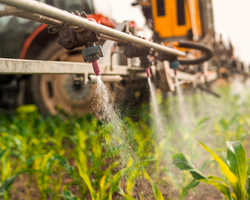Crop Protection Supply Chain Update
Feb 15, 2023
Article Provided by: Tres Gutierrez
First and foremost, we will have adequate supply to meet our customers’ needs for the 2023 crop year.  However, where does this supply come from, and how does it get here? Did you know roughly 80% of the pesticides used in the U.S. have an active or inactive ingredient sourced from China? India is actively trying to take market share from China to level the playing field, however, they have a long road ahead.
However, where does this supply come from, and how does it get here? Did you know roughly 80% of the pesticides used in the U.S. have an active or inactive ingredient sourced from China? India is actively trying to take market share from China to level the playing field, however, they have a long road ahead.
As this product makes its way to the U.S., it takes an average of 60 days to get from port to port and then to a production facility. Production takes an average of 21 days and then another 7 to 14 days to a distributor or retail outlet. In a perfect world, this process would take 3-4 months from beginning to end. In 2021 and 2022 we experienced 6-9 month wait times, primarily due to severe port congestion and trucking shortages. Turnaround times were getting so out of hand, some companies leased cargo planes to fly in product.
Pre-COVID, the U.S. faced a trucking shortage with the industry needing about sixty thousand drivers. During COVID, the shortage grew another twenty thousand. Today, we are still short tens of thousands of drivers. Thankfully, the port congestion has subsided, and vessel wait times, at some ports, are back to pre-COVID norms. In turn, this has taken some pressure off the trucking industry.
What does all this mean for crop protection in 2023 and beyond? Our current crop protection supply is healthy across MKC, Midwest Fertilizer, and FarmKan. With the bottleneck clearing at the ports, supply has been flowing much faster. Early predictions beyond the 2023 crop year continue to show a healthy supply chain.
The supply we have for today and tomorrow, is only made possible with the true partnership we have between our customers, sales staff, and vendors.
First and foremost, we will have adequate supply to meet our customers’ needs for the 2023 crop year.
 However, where does this supply come from, and how does it get here? Did you know roughly 80% of the pesticides used in the U.S. have an active or inactive ingredient sourced from China? India is actively trying to take market share from China to level the playing field, however, they have a long road ahead.
However, where does this supply come from, and how does it get here? Did you know roughly 80% of the pesticides used in the U.S. have an active or inactive ingredient sourced from China? India is actively trying to take market share from China to level the playing field, however, they have a long road ahead.As this product makes its way to the U.S., it takes an average of 60 days to get from port to port and then to a production facility. Production takes an average of 21 days and then another 7 to 14 days to a distributor or retail outlet. In a perfect world, this process would take 3-4 months from beginning to end. In 2021 and 2022 we experienced 6-9 month wait times, primarily due to severe port congestion and trucking shortages. Turnaround times were getting so out of hand, some companies leased cargo planes to fly in product.
Pre-COVID, the U.S. faced a trucking shortage with the industry needing about sixty thousand drivers. During COVID, the shortage grew another twenty thousand. Today, we are still short tens of thousands of drivers. Thankfully, the port congestion has subsided, and vessel wait times, at some ports, are back to pre-COVID norms. In turn, this has taken some pressure off the trucking industry.
What does all this mean for crop protection in 2023 and beyond? Our current crop protection supply is healthy across MKC, Midwest Fertilizer, and FarmKan. With the bottleneck clearing at the ports, supply has been flowing much faster. Early predictions beyond the 2023 crop year continue to show a healthy supply chain.
The supply we have for today and tomorrow, is only made possible with the true partnership we have between our customers, sales staff, and vendors.